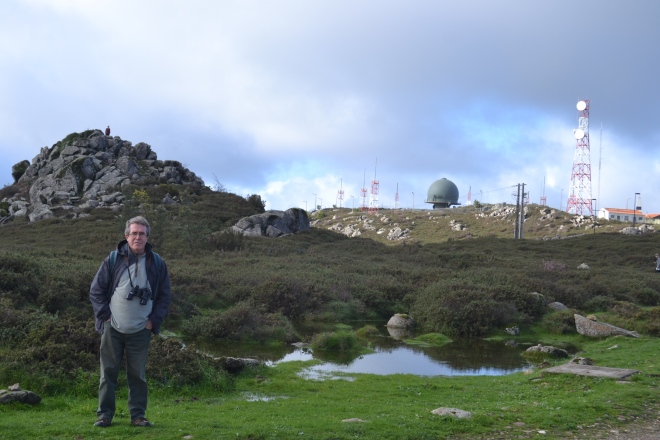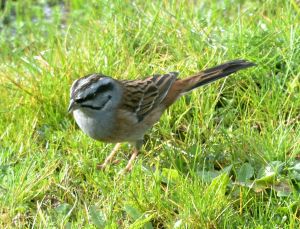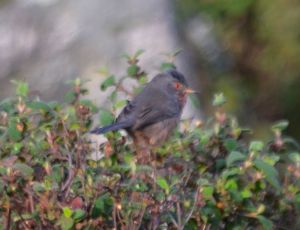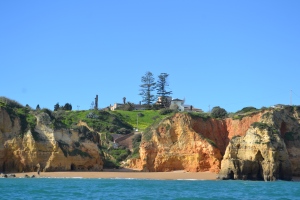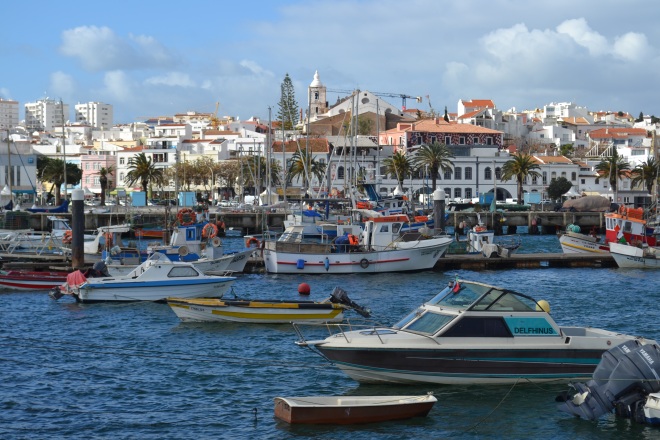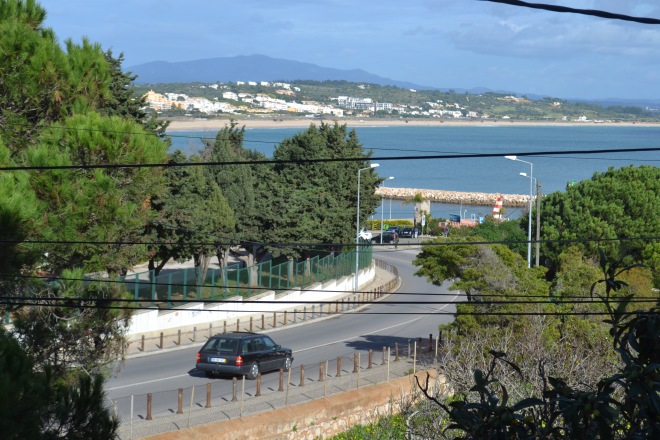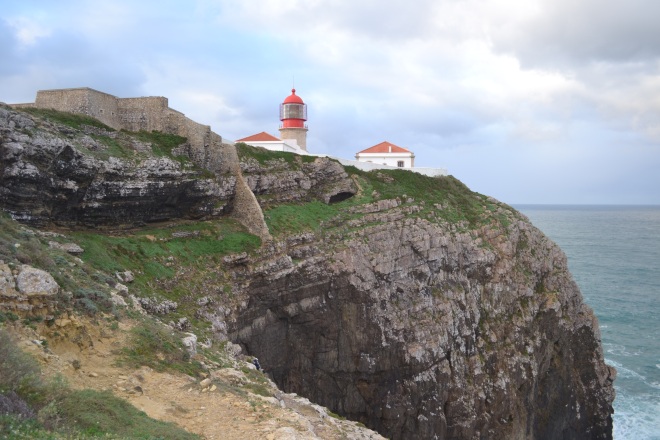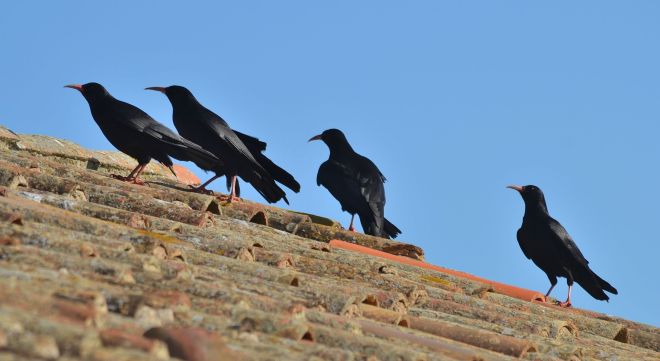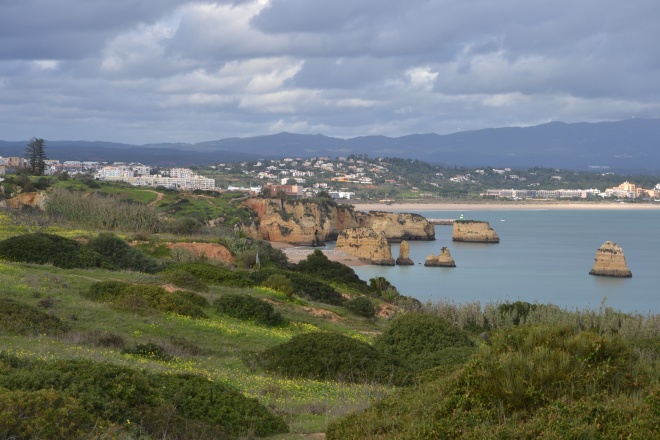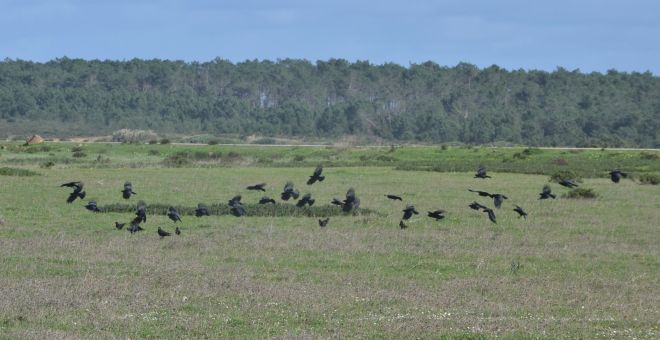Not many regularly occuring birds remain on my southern Europe wish list now but of the lingerers, three – Pin-tailed Sandgrouse, Rock Sparrow and (Greater) Spotted Eagle – all winter in Provence. Finding a £53 flight (luggage included) from Lisbon to Marseilles with the Portuguese airline TAP meant I could add a winter visit here to my Algarve break. And so the opportunity to find these birds has arisen.
My base is the cheap and cheerful, self catering Top Motel in Istres. I find this arrangement ideal because French breakfasts aren’t worth their cost and evening meals also become more affordable. Then there is the essential of tea and coffee whenever I want one, that isn’t possible in a budget chain hotel unless a kettle is smuggled in. Oh, and this establishment in a secure compound behind the 3-star Ariane Hotel is also hard by the Plaine de la Crau Sandgrouse site, and conveniently placed to visit birding sites in les Alpilles and la Camargue.
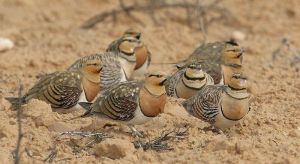
Pin-tailed Sandgrouse © rights of owner reserved
The resident Pin-tailed Sandgrouse had huge lifer status for the usual reason that I had not found the species on two previous visits to Provence in May 2012 and March 2013. Doing so was my top priority this time. Trip research had revealed a hitherto untried access point to la Crau, at the north-western end near the town of St-Martin-de-Crau, that appeared to be a good PTS location. This is the reserve Peau de Meau, managed by a regional association for nature conservation, CEEP (Conservatoire Etudes des Ecosystemes de Provence). After getting a permit dutifully from CEEP’s Ecomusee de la Crau in Saint-Martin, I arrived on site late on Wednesday morning (20th), having first seen to buying provisions. Stomach again, call myself a birder?
After 2013’s visit I had concluded the best way to find PTS would be driving slowly around the flat, stoney “Coussoul” habitat of la Crau in a 4×4 seeing what goes up. This time my car hire company substituted a chunky, diesel-engined Renault Captur for the small car I had booked – almost a 4×4 then and at no extra cost. Their £12/day insurance package had no deposit and no excess, so if I wrecked the vehicle I’d be covered. “I won’t even look at it when you bring it back,” the lady said. Well, I needn’t be too squeamish about where I take it then!
Peau de Meau has a 5km waymarked trail around it’s perimeter, but first I set off in the car along a rough track for some distance beyond the reserve. After all I had been wanting to do that for the past three years and there was nobody there to stop me. Seeing only Pipits, Skylarks and corvids I returned to walk the full distance of the trail, but still no Sandgrouse. So I applied my usual solution to a no show, deciding to return early the next day. But first I took another drive through the rough roads of la Crau eventually reaching the N508 road that runs north-west between the Plaine and the neighbouring Camargue. Guess what? At track’s end was a roadside notice proclaiming access to this military land is prohibited. Oh well!
![DSC_0027[1]](https://ramblingsnscribblings.files.wordpress.com/2016/01/dsc_00271.jpg?w=660)
La Plaine de la Crau
Thursday 21st dawned cold and bright and I arrived back at Peau de Meau at 8am. For the sake of doing things differently I set off the other way around the trail, then took a track across the reserve towards the large barn in the picture. All that went up were Skylarks and frustration was setting in. Then continuing north-eastward along the main trail from the barn, two birdy events occured in quick succession. Buses!
First, away to my left four Little Bustard went up before seemingly vanishing into thin air. Quite an achievement for such a large bird but a not unusual experience for the species. That also maintained my 100% record for it at this site. Then away on my other side, five Pin-tailed Sandgrouse at last flew across the sunny morning expanse of the Coussoul. Mission accomplished! The middle distance flight view was pretty much what I had expected. I have seen some good birds in the past at la Crau: Little Bustard, Stone Curlew, Red-backed Shrike, Tawny Pipit, Melodious Warbler and a possible Spotted Eagle that I didn’t put on my life list. Now having gained the elusive top prize I felt very relieved not to have to re-visit this flat and otherwise dour landscape unless I choose to.
It was now mid-morning and my next target, Rock Sparrow was at a roost site. I felt little inclination to drive around the Plaine again illegally in the low sun, and so moved on to reconnoitre a previously unvisited area of la Camargue on the western edge of l’Etang’s de Malagroy and Vaccares. I found out about this location through an online trip report that said Greater and Lesser Spotted Eagle were both present in January 2014. From Cacheral on the D85A road I followed a rough track NNE all the way to the D37 that skirts the Etang de Vaccares’ northern side.
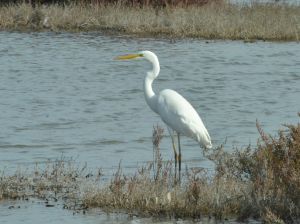
Great White Egret
It was now a perfect cold, sunny winter’s day and the abundant Greater Flamingo all looked very splendid in their finery. In places there were almost as many white Egrets: Cattle, Little and occasional Great White’s (pictured above), emphasising just what a concentration of large water birds dwell here. Where Eagles were concerned I came across a good candidate for Spotted and also observed two of the Buzzard-sized Booted species. There are extensive reed beds in this area and many hiking trail signs.
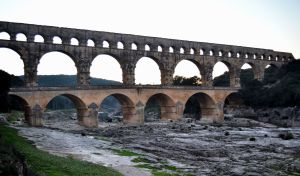
Magnificent Pont du Gard at dusk
In the afternoon I drove north to the Roman aqueduct of Pont du Gard, a UNESCO world heritage site between Nimes and Avignon. This 360 metre long three tier structure is the tallest bridge in the Roman world at 50 metres. Straddling a gorge through which flows the River Gardon, it is a well developed tourist attraction and also a winter roost site for Rock Sparrow. I arrived early to get my bearings – there is a car park on either side – then after a sandwich break returned at 4pm
Stone staircases lead up to just below the top tier at both ends and the question was at which one to set up my scope. I decided the western one had the better views and watched and waited. At 4:45pm a Wallcreeper flew in three arches away that I watched foraging for food for the next 20 minutes. This delightful bird, my second ever proved quite a distraction but then I recalled what I was meant to be doing and scanned to the far end of the aqueduct.
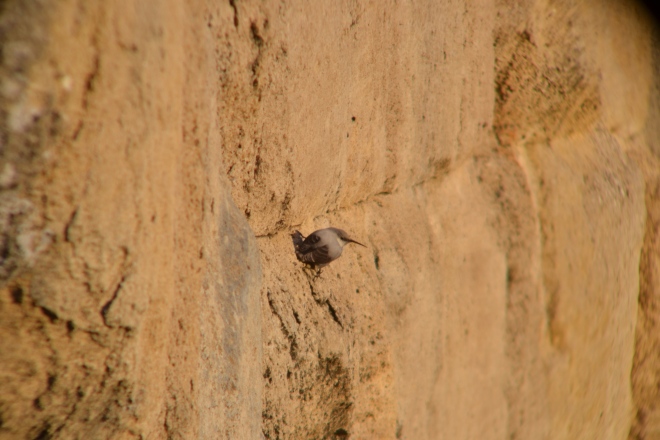
Slightly less blurry Wallcreeper than at Dinant
Small birds now appeared to be flying straight in to the structure but were actually entering cracks and cavities of any kind in the top tier. These were indeed the Rock Sparrow I had come to see. Some would fall out of their hiding places again, flying downwards while others perched on the parapets or clung Wallcreeper-like to the vertical surface. The head pattern was plain to see even at that range, then zooming in with my eyepiece on one bird I picked out clearly the yellow breast spot of a male.

My vantage point at Pont du Gard
![rotsmus-rock-sparrow-04[1] Rock Sparrow © rights of owner reserved](https://ramblingsnscribblings.files.wordpress.com/2016/01/rotsmus-rock-sparrow-041.jpg?w=311&resize=311%2C228&h=228#038;h=228)
Rock Sparrow © rights of owner reserved
There was still enough daylight time left to cross over to the eastern side but once I got there the activity had largely ceased. But the Wallcreeper was still busying itself, now on the upper tier as well. This experience was well worth the 12 euros admission money to the site and I felt very satisfied to have added Rock Sparrow to my life list at the first attempt.
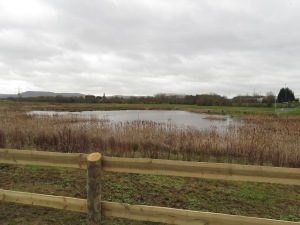
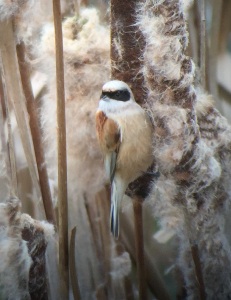

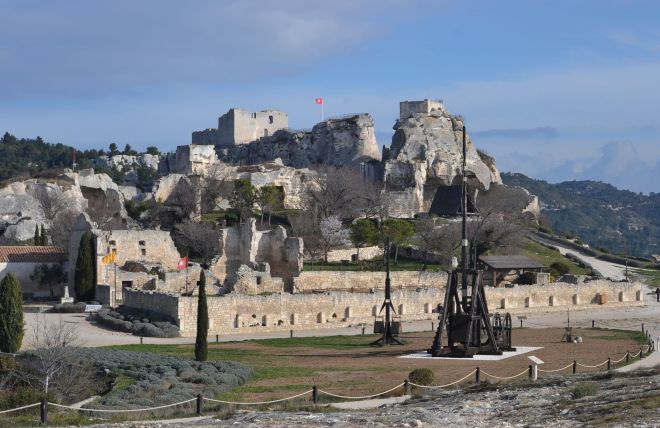
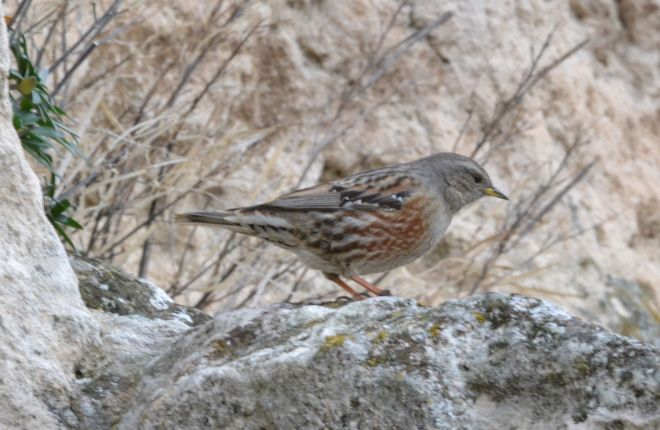






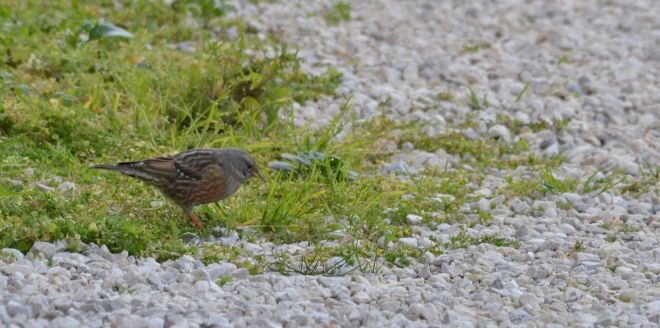
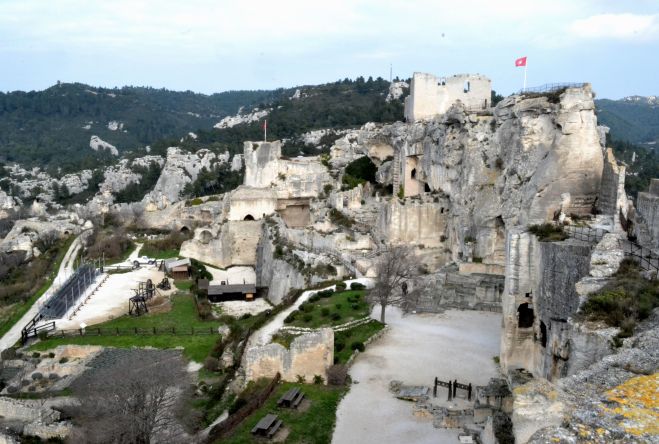
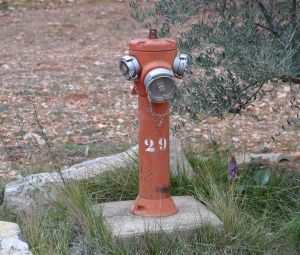
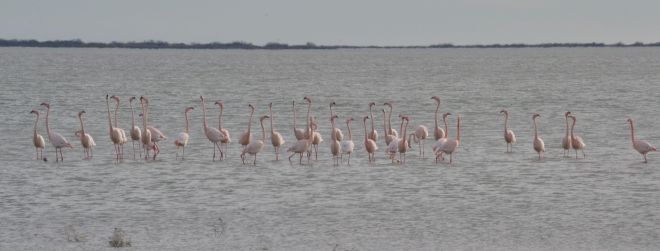

![DSC_0027[1]](https://ramblingsnscribblings.files.wordpress.com/2016/01/dsc_00271.jpg?w=660)




![rotsmus-rock-sparrow-04[1] Rock Sparrow © rights of owner reserved](https://ramblingsnscribblings.files.wordpress.com/2016/01/rotsmus-rock-sparrow-041.jpg?w=311&resize=311%2C228&h=228#038;h=228)
